One of the most remarkable trends in the Indian tablet industry over the
past year has been the rise of the budget segment of tablets. Micromax
is one of the major players in this segment, and can take credit for
kick-starting the demand with its Funbook tablet, which claimed to combine
entertainment with education.
Micromax's Canvas Tab P650 is a
tablet with 8-inch display, a segment which has been dominated by Apple
and Samsung for quite some time now. But can the Micromax Canvas Tab, the
company's first 8-inch tablet and also the first flagship tablet in the
Canvas series, repeat the success of the first Funbook, and get ahead of
the competition? We try to find out in our review.
Design/ BuildThe
Micromax Canvas Tab is built along the lines of Micromax's high-end
smartphones, like the Canvas Doodle 2. On first look, the Canvas Tab
looks like a stretched out or bigger version of the Funbook tablet.
However, that is only the case for the front panel of the tablet.
The
front of the Canvas Tab features a broad bezel around the screen,
similar to Funbook tablets, although this makes the display look a lot
smaller than it actually is. It comes with a glossy screen and therefore
attracts more than a fair share of fingerprints; we would recommend
carrying a cloth to keep cleaning it. Apart from the screen, the
tablet's front houses a 2-megapixel camera placed in one corner
alongside the earpiece that sits in the centre.
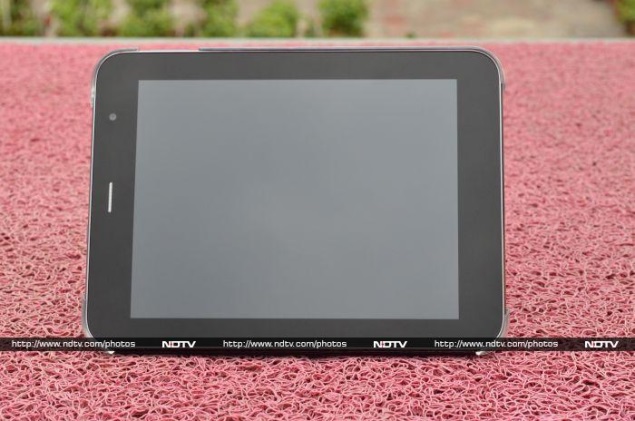
The back of the
Canvas Tab has a brushed aluminium finish which gives it classy looks, with a
section at the top which looks removable (The back panel cannot be
detached as it has been screwed on), though is not. Micromax has got rid
of the cheap plastic body and equips an aluminium body at the back,
which does feel better to hold than the Funbook tablets. Lodged in the
back is a 5-megapixel autofocus camera at the top left corner and the
speaker grill.
The tablet's rear also houses Micromax logo branding
embossed in the centre with the model name - 'Canvas Tab' along with
inbuilt storage capacity printed at the bottom, something we have seen
on Apple's iPad models.
At slightly over 10mm, the Canvas Tab is not the thinnest
tablet we have seen but is comfortable enough to hold with both hands.
In terms of weight, the tablet stands on the heavier side which is due
to the aluminium back panel.
We tried to use the tablet with one hand
but failed because of the squarer form-factor of the Micromax Canvas Tab, while
we think using the more rectangular Samsung Galaxy Tab 3 311 (8-inch model) with one hand
was much easier task than the Canvas Tab.
The Micromax Canvas Tab
is available in two colour variants - Marine Blue and Pristine White,
we received the former one. Physical keys on this tab comprise just the
volume and power buttons - the rest of the controls are on the 8-inch
tablet.
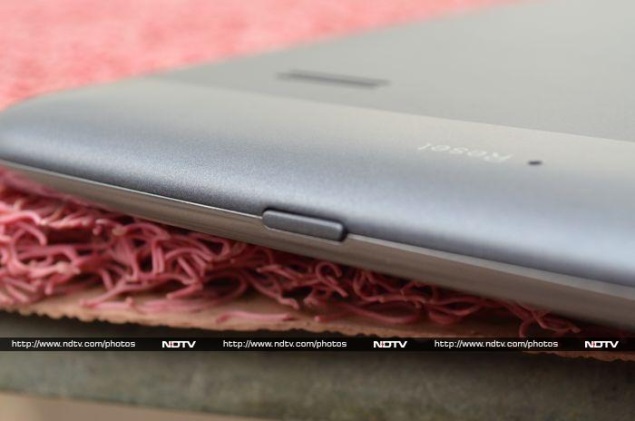
We have been using the Canvas Tab for quite some time
now, but still have not been used to the odd positioning of the power
button on the top, and the awkwardly small volume toggle on the right
side. Often, we ended up pressing the volume rocker keys to unlock the
tablet and at times while watching videos we struggled to adjust the
volumes. The power key is on the top panel of the tablet almost above
the earpiece grill, which we feel was very inconvenient for
right-handed individuals. The 8-inch form factor sometimes feels too big for
reaching out to the power button.
There is 3.5mm audio jack and
Micro-USB port sitting at the top of the Canvas Tab, while the left side is bare. Just
below the volume rocker buttons is a flap which is removable and reveals
the SIM card and microSD card slot.
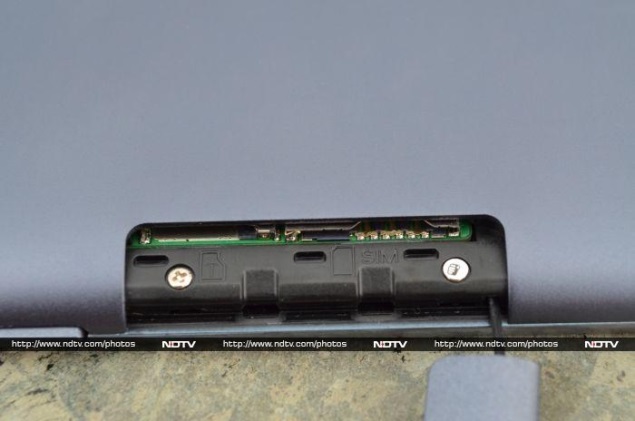
The
flap covering the two slots is
connected by a rubber material which doesn't look durable to survive in
long run. The company has chosen regular SIM for the Canvas Tab, instead
of
the smaller forms (micro-SIM / mini-SIM). We also felt the Canvas Tab to
be a bit too heavy, with a weight of 425 grams in this form factor,
more than a hundred grams heavier than iPad mini and Galaxy Tab 3 211.
Display
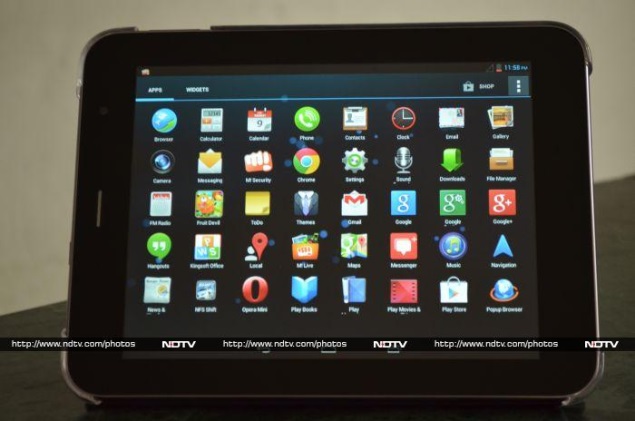
The
Micromax Canvas Tab comes with an 8-inch IPS display with a resolution
of 1024x768 pixels, which translates to a pixel density of 160ppi
(pixels per inch). The display resolution of the Canvas Tab is
comparable to Apple iPad mini (1024x768) but lower than some of the
7-inch tablets which are available at lower prices, such as the Nexus 7
(2012) and Kindle Fire HD, which have a resolution of 1280x800 pixels.
The
Micromax Canvas Tab's display is crisp enough to make reading
comfortable and we enjoyed watching video on the bright display thanks
to the accurate colour reproduction, and deep blacks.
The Canvas
Tab supports wide-viewing angles which mean users are not required to
hold it in an exact sweet spot for the best viewing experience. This also
means playing games that utilize the accelerometer won't get spoiled by
occluded views and distorted colours. However, we noticed that the
screen is very reflective and this hampers visibility under the
sunlight.
The touch sensitivity of the Micromax Canvas Tab is
decent and we did not encounter any issues while using the tablet. But
considering the price of the new Micromax's tablet, we expected that
company could have gone for a better display panel with higher
resolution.
Camera
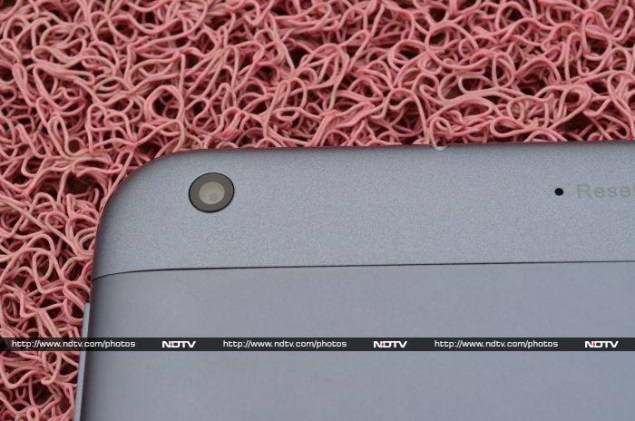
The Micromax Canvas Tab comes with dual cameras - 5-megapixel rear autofocus camera and a 2-megapixel front-facing camera.
The
rear camera takes decent pictures in well-lit conditions. We tested the
Canvas Tab's rear camera in outdoor, dim and
indoor environments and found that pictures were a bit washed out and
grainy at edges. There is a little bit of lag between pressing the
button and the actual shutter release, making it hard take pictures in a
pinch.

However,
we must confess that Canvas Tab's rear camera is a little above the
average tablet camera and gets a significant boost from a good camera
app, which is another element that is familiar to Micromax's Canvas
series smartphones. The tablet's camera app comes with same layout and
much of the same functionality as seen already on the Micromax Canvas 4
smartphone and Micromax Canvas Doodle 2 phablet. Notably, there's no flash on the
Canvas Tab.

With
the Micromax Canvas Tab's camera app, users can
choose from a host of camera settings like Normal, HDR, Face Beauty,
Smile detection, Exposure compensation, Panorama, Photosphere
(multi-angle view) modes. It also offers a burst mode, letting users
click 40
to 99 shots at once; users just need to long-press the camera soft key
on the display to take burst shot.
The Canvas Tab is capable of
recording video at 768x1024 pixels and the preloaded camera app also has
the option of adding filters to the clicked images as well. The front
facing 2-megapixel camera is pretty average and can be used for video
calls over Skype or self-portrait shots.
Software/ InterfaceThe
Micromax Canvas Tab runs Android 4.2.1 Jelly Bean, which is a very
recent version of the OS and comes with some minor software tweaks like
the app icons.
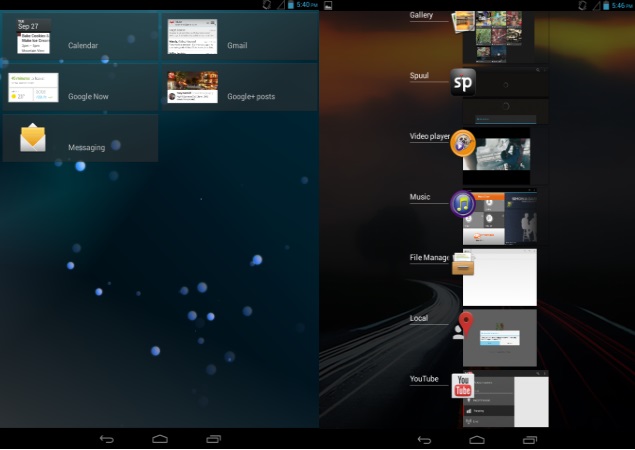
Likewise, Micromax has skinned some UI elements of
the operating system on the Canvas Tab and offers four themes that come
with different icon sets. Even the default theme on the tablet that
offers stock icons has undergone some minor tweaks with Micromax
choosing a squared icon look instead of the plain that is being offered
on stock Android. However, we must confess that the changes are not as
radical as HTC's Sense UI or Samsung's TouchWiz but adds a few neat
touches to the OS without intruding too much on its essence.
Some
might consider that with Android 4.4 KitKat around the corner, the fact
that the Canvas Tab still runs Android 4.2.1 is a let-down. However, we
really do not mind a smoothly running Android 4.2 tablet and the Canvas
Tab is that. Another fact is that in India it might take a while for
smartphones and tablets based on Android platform start running on the
latest released OS version, except the Nexus range of devices. The OS
update will take some time to reach domestic OEMs.
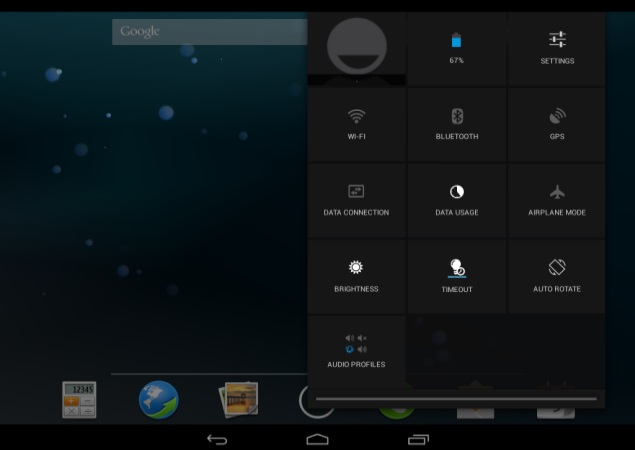
One can get
lock-screen widgets on the Canvas Tab, which is an Android 4.2 feature.
For unlocking the device one can choose from the clock, camera, Gmail,
Google Now, messaging and additionally widgets offered by third-party
apps installed on the tablet. This Android 4.2 Jelly Bean feature
enables users to perform certain app actions even when the device is
locked. One can also launch the camera direct from the lock screen by
pressing the power button and then swiping screen on the right.
Much
like Micromax's Canvas 4 and Canvas Doodle 2, the Canvas Tab also comes
with FOTA (firmware over the air ) feature that allows to wirelessly
downloading firmware updates directly to the device. There are five
customizable homescreens - a very standard Android affair.
There
are shortcuts for calculator, native browser, gallery, menu, dialler,
messages and calendar on the homescreen of the Canvas Tab. Similar to
other Android 4.2 Jelly Bean-based devices, the notifications tray on
the tablet features settings shortcut and a clear all button. However,
the Canvas Tab much like other Android 4.2 tablets come with two
separate notification trays - one with Quick settings and other with
email, messages, and other alerts.
On expanding the Quick Settings
notification tray one can find options for quick access to the profile,
battery status, settings shortcut, Wi-Fi, Bluetooth, GPS, data
connectivity, data usage status, airplane mode, brightness, screen
timeout, auto rotate and audio profiles (for alerts and other
notifications).

The Micromax Canvas Tab also features Google Now,
an Android 4.2 feature which is a voice-based information assistant and
an extension of Google search. It uses cards which are essentially small
boxes that offer different sets of information like weather forecast,
directions, traffic information, scores, appointments and currency
conversion etc.
The Micromax Canvas Tab comes preloaded with a
number of apps such as Spuul, which can stream movies and television
shows; Kingsoft Office Suite, for creating and editing Office files,
and M! Security, which is powered by NQ Mobile for warding off virus and
malware attacks. However, the M! Security app is not completely free
and users need to pay for using the premium features of the app. Also on
board in the tablet is M! Live that gives access to download music,
videos, games and apps from M! Live store.
The Canvas Tab's native
music player and the video player are the same as seen on the Canvas 4
and Canvas Doodle 2. The music player UI is a complete revamp with
access to company's online music store, while the video player comes
with the 'Pause on Look away' feature that detects when you are looking
at the screen and stops the video when it does not detect user's face.

The
Canvas Tab also comes preloaded with host of Google apps such as Gmail,
Google Search, Google+, Hangouts, Google Maps, Play Books, Play Movies
and TV, Play Store and YouTube. There is FM radio support on the tablet
as well.
Performance/ Battery LifeThe Micromax Canvas Tab
is powered by a quad-core 1.2GHz MediaTek 8389 processor. It has 1GB of
RAM onboard, and comes with 16GB of inbuilt storage, out of which only
11.07GB is user-accessible and also supports expandable storage up to
32GB via microSD card.
Considering there is a fairly respectable
quad-core processor running under the hood, the Micromax Canvas Tab
manages to chug along just fine. In day-to-day activities the tablet
feels smooth enough and you are not really left wanting for more power.
However, we did notice some minor lag especially while switching from
portrait to landscape mode but other than that we were able to play
tablet-optimised games and HD video clips, without barely any hiccups.

The
8-inch IPS display is good for viewing movies and videos. The Canvas
Tab was able to play full-HD videos and supported popular video formats
like
.AVI, .MOV, .MKV and .MP4. The speakers on the Canvas Tab deliver
average sound that distorts a bit at high volume levels and overall the
output through the speaker grill was not very loud as well.
The
Micromax Canvas Tab comes with single-SIM support (as we mentioned earlier, using the regular SIM
size) and also offers voice-calling abilities, apart from 3G data connectivity. However, we felt that the
Canvas Tab was too big to make phone calls with and was almost
impossible to use as a smartphone while making calls. We preferred not
to put the tablet next to our face, but instead used supplied earphones.
We confess that the calling abilities in the tablet do give it an
advantage compared to other tablets in the same price segment without the feature.
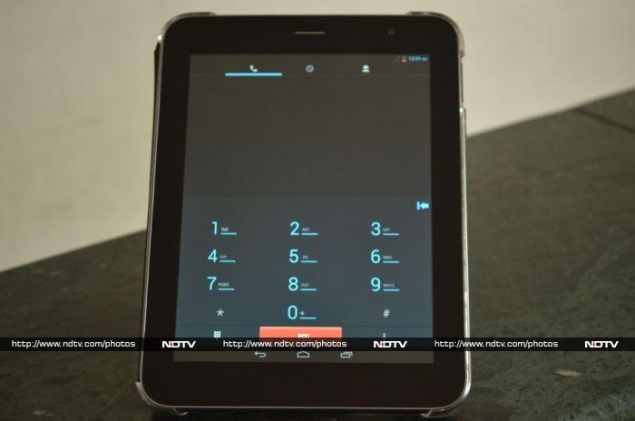
The Canvas Tab is smooth and speedy
when opening apps, swiping around the interface, and playing games like
Temple Run 2 with rich graphics quality. The onscreen keyboard's keys
are not cramped and users can hit them easily.
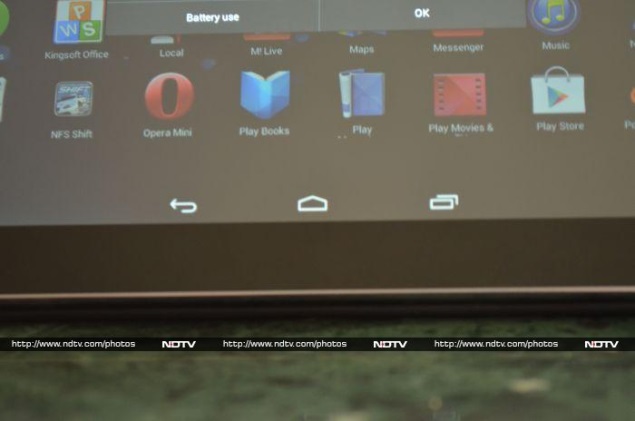
The Micromax
Canvas Tab ships with a 4800mAh battery that according to the company
can deliver up to 10 hours of talktime and up to 400 hours of standby
time. Based on our usage, we see the tablet does delivers
satisfying battery performance.
With medium to heavy usage (leaving brightness on Auto) on the Micromax Canvas Tab, we were
able to get more than a day before needing to charge the device. The
4800mAh battery lasted around 6 hours watching HD videos before getting
down under 20 percent with the brightness set to auto.
With Wi-Fi
turned on for all time and using the tablet for Web browsing for an
hour, a few calls lasting for not more than an hour, display set on
auto-brightness and with the usual notifications for messages, emails,
Facebook, and WhatsApp, the device lasted for about 16 to 18 hours which
is decent time for a tablet of this size. One might get more battery
backup depending on the usage, and also by adjusting settings
(brightness, Wi-Fi, data).
VerdictThe Micromax Canvas Tab
has been launched at Rs. 16,500 which is a bit pricey. However, we admit
that the Canvas Tab is definitely a step up in terms of build quality,
performance and connectivity, if compared to Funbook tablet models.
At
this price, the 3G-enabled Canvas Tab squares off against the Samsung
Galaxy tablets - the Galaxy Tab 3 211 priced at Rs. 17,100, which comes
with 7-inch
display and voice-calling features, and the Galaxy Tab 3 310 priced at
Rs. 21,000,
which is a Wi-Fi variant and comes with 8-inch display, and misses
out on the calling abilities.
The larger display doesn't
really give the Canvas Tab much of an advantage over the Galaxy Tab 3
211, and single-handed operating is not too easy with the square form
factor. There unfortunately aren't too many options available for you to
choose from in the market, with older-generation offerings like the
iberry Auxus Core X4 3G, which features dated Android version, or
lower-specced devices like Galaxy Tab 3 211.
If you are
comfortable with the weight and the form factor, and want the quad-core
performance and recent OS iteration, the Canvas Tab P650 is not a bad
option.
Price: Rs. 16,500

Micromax Canvas Tab P650 in picturesPros
- Solid build
- Good display
- Voice-calling
- Decent battery backup
Cons
- A bit heavy for daily use
- Speakers not very loud
- A little pricey
Ratings (Out of 5)
- Design: 3.5
- Display: 3.5
- Camera: 3
- Performance: 3
- Software: 3
- Battery Life: 3.5
- Value for Money: 3
- Overall: 3
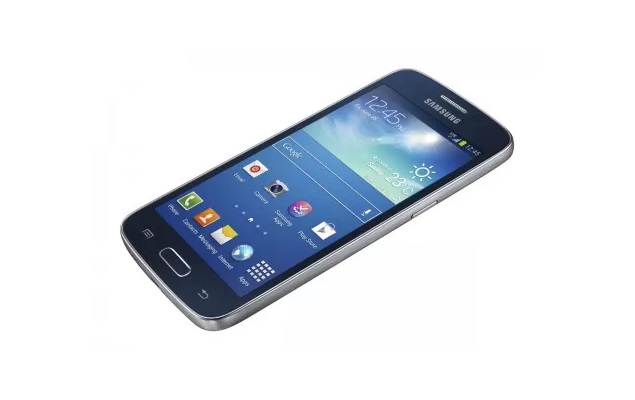












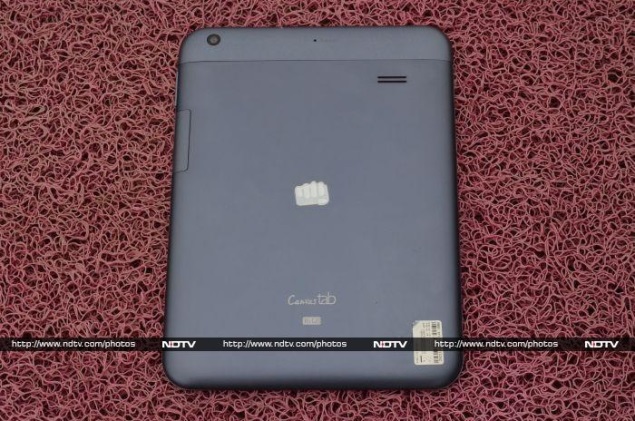















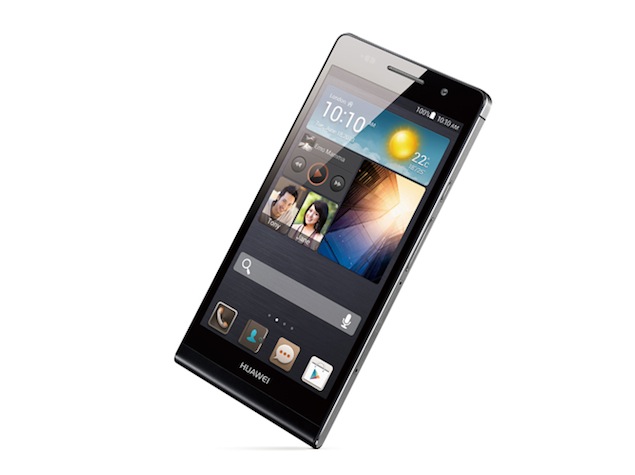


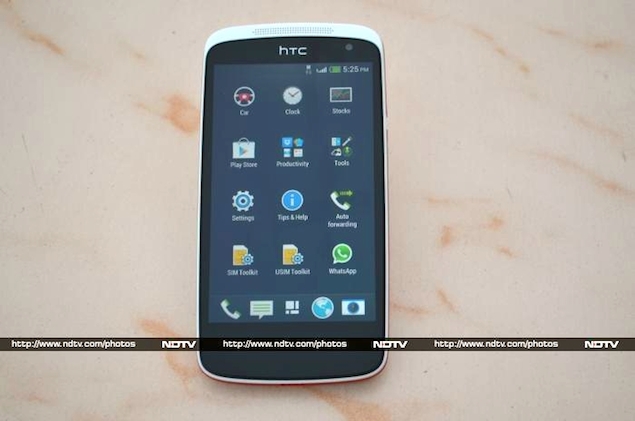
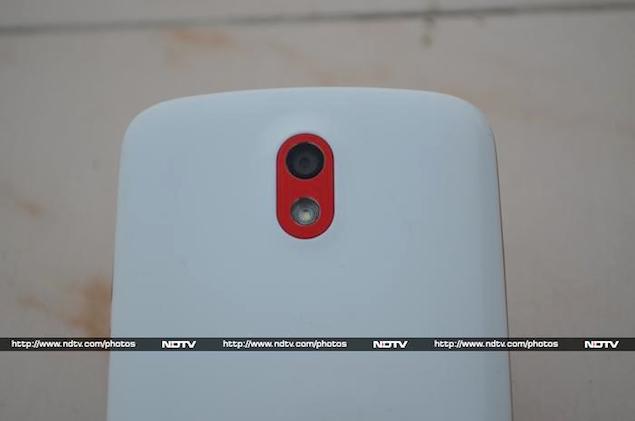
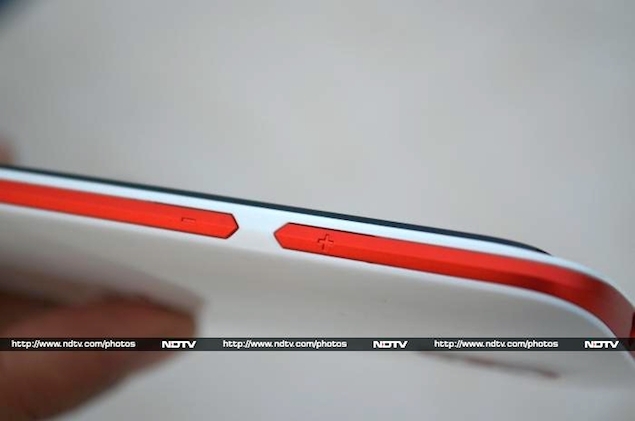





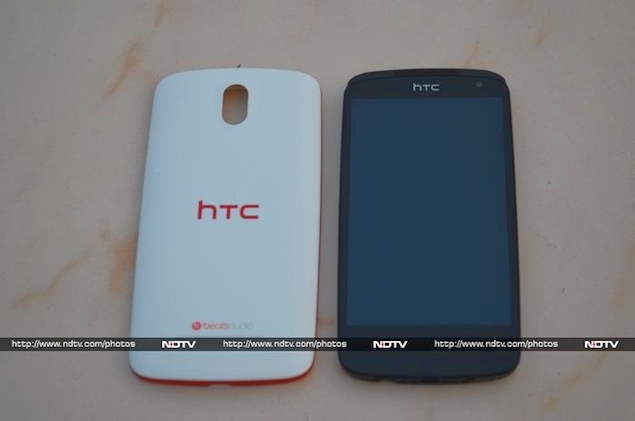


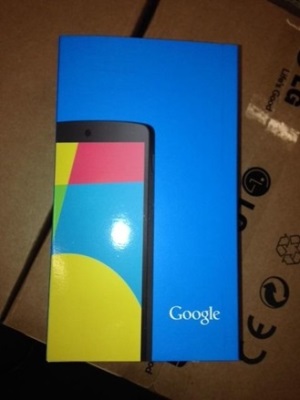
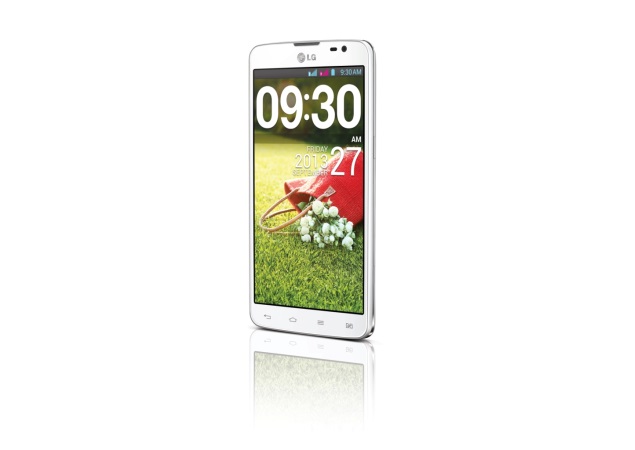

 .
.